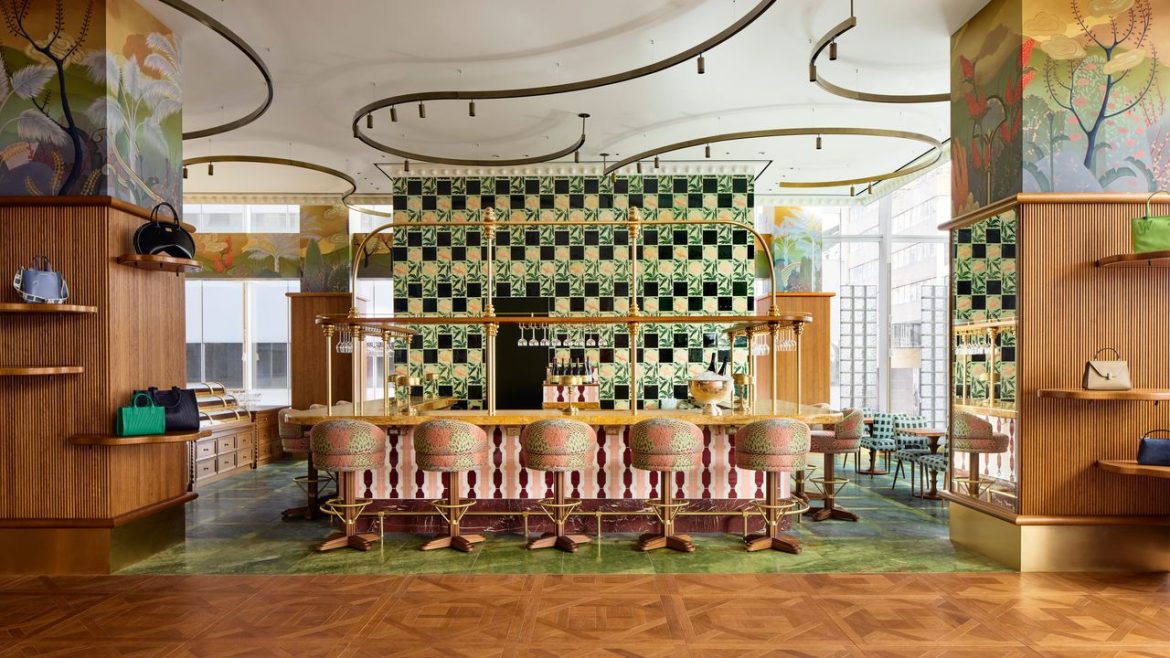
At Printemps, the cuisine is just as integral to the experience as the shopping, coaxing individuals away from their devices and into the physical spaces, fostering exploration and the opportunity to savor the moment. “We aim for a more hospitable atmosphere overall,” Gourdet explains. This creates a deliberate unity, where dining and retail seamlessly intertwine into one refined sensory journey.
Consuming meals within department stores isn’t a novel concept. Barney’s featured Fred’s, Bergdorf Goodman hosts BG, Ralph Lauren launched RL Restaurant in 1999, followed by numerous branded cafés worldwide. However, this current surge of high-fashion dining, led by Gourdet along with a new wave of culinary talents, indicates a significant cultural transformation. Dior enlisted Dominique Crenn for its Café Dior in Dallas and the Monsieur Dior eatery in Beverly Hills, Tiffany & Co.’s Blue Box Café in New York is managed by Daniel Boulud, and Gucci Osteria, led by Massimo Bottura’s team, can also be found in Beverly Hills (where it received a Michelin star), along with locations in Seoul, Tokyo, and Florence. So, why are the leading names in fashion committing fully to hospitality?
“In the aftermath of the pandemic, maisons [or luxury fashion houses] are transforming flagship stores from static displays of products into lively experience centers,” states Claudia D’Arpizio, senior partner and global fashion and luxury head at Bain & Company. “Food and beverages act as attractions for foot traffic, extended stays, and return visits.”
This approach aligns with a wider rethinking of luxury itself. For a considerable part of the modern age, wealth has bought reputation. Status could be attained, adorned, and showcased through items like a designer handbag or a limited-edition watch. However, Bain’s findings reveal that “experiential luxury” now constitutes nearly 60% of worldwide luxury expenditure. Wealth is articulated not only through possessions but also through experiences. Dining, traveling, and wellness have all emerged as influential status indicators, prompting luxury retailers to adapt to this new landscape.
“Presently, an increasing percentage of the top 50 luxury brands are running at least one branded or co-developed food and beverage initiative,” D’Arpizio reports. These projects span from cafés and bistros to upscale dining experiences and chef collaborations, representing “a marked increase from just a few examples five years prior,” D’Arpizio adds. “What started as decorative or marketing-focused pop-ups has progressed into a key aspect of brand experience and customer interaction.”
Economic factors may also play a role. Following a decade of brisk growth, global luxury sales have stabilized while expenditure on experiences continues to rise. Simply put, this means opting to create memories instead of accumulating items—traveling to attend a major art exhibition or a Taylor Swift show, or kneading cavatelli in a practical pasta workshop with a chef from the community. Alternatively, for the fashion-forward, it might involve tasting a Tiffany blue petit four during afternoon tea at the luxury jewelry brand’s Blue Box Café.

